人教版初中英语中考知识点总结全册
- 格式:docx
- 大小:240.54 KB
- 文档页数:66
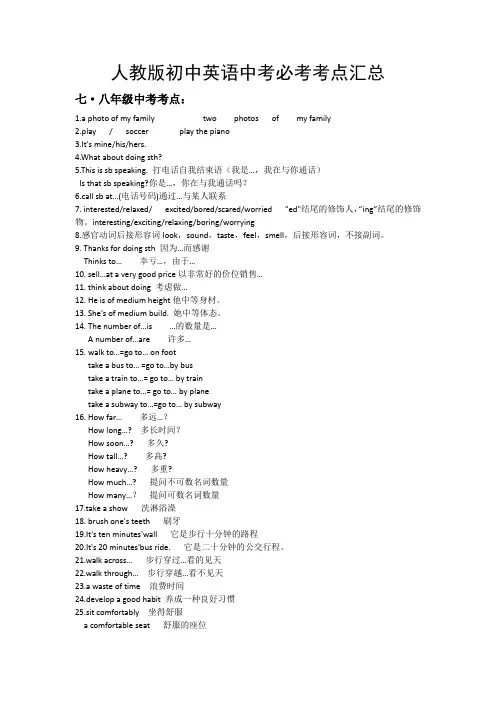
人教版初中英语中考必考考点汇总七·八年级中考考点:1.a photo of my family two photos of my family2.play / soccer play the piano3.It's mine/his/hers.4.What about doing sth?5.This is sb speaking. 打电话自我结束语(我是…,我在与你通话)Is that sb speaking?你是…,你在与我通话吗?6.call sb at…(电话号码)通过…与某人联系7. interested/relaxed/ excited/bored/scared/worried "ed"结尾的修饰人,“ing”结尾的修饰物。
interesting/exciting/relaxing/boring/worrying8.感官动词后接形容词look,sound,taste,feel,smell,后接形容词,不接副词。
9. Thanks for doing sth 因为…而感谢Thinks to…幸亏…,由于…10. sell…at a very good price以非常好的价位销售…11. think about doing 考虑做…12. He is of medium height他中等身材。
13. She's of medium build. 她中等体态。
14. The number of…is…的数量是…A number of…are许多…15. walk to…=go to… on foottake a bus to… =go to…by bustake a train to…= go to… by traintake a plane to…= go to… by planetake a subway to…=go to… by subway16. How far…多远…?How long…?多长时间?How soon…?多久?How tall…?多高?How heavy…?多重?How much…?提问不可数名词数量How man y…?提问可数名词数量17.take a show 洗淋浴澡18. brush one's teeth 刷牙19.It's ten minutes'wall 它是步行十分钟的路程20.It's 20 minutes'bus ride. 它是二十分钟的公交行程。
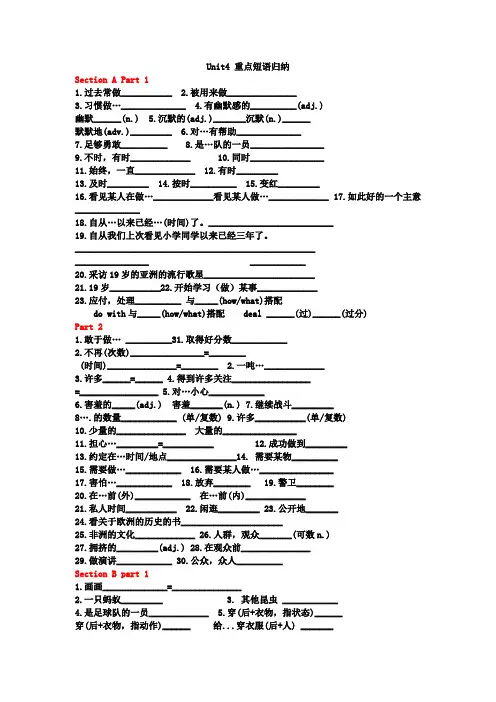
Unit4 重点短语归纳Section A Part 11.过去常做___________2.被用来做_______________3.习惯做…______________4.有幽默感的__________(adj.)幽默______(n.) 5.沉默的(adj.)_______沉默(n.)______默默地(adv.)_________ 6.对…有帮助______________7.足够勇敢__________ 8.是…队的一员________________9.不时,有时_____________ 10.同时________________11.始终,一直_____________ 12.有时_________13.及时_________ 14.按时__________ 15.变红_________16.看见某人在做…_____________看见某人做…_____________ 17.如此好的一个主意______________18.自从…以来已经…(时间)了。
___________________________19.自从我们上次看见小学同学以来已经三年了。
____________________________________________________________________ ____________20.采访19岁的亚洲的流行歌星________________________21.19岁___________22.开始学习(做)某事_____________23.应付,处理__________ 与_____(how/what)搭配do with与_____(how/what)搭配 deal ______(过)______(过分)Part 21.敢于做… __________31.取得好分数____________2.不再(次数)________________=________(时间)_______________=________ 2.一吨…_____________3.许多______=______4.得到许多关注_________________=_________________ 5.对…小心____________6.害羞的_____(adj.) 害羞_______(n.)7.继续战斗_________8….的数量____________ (单/复数) 9.许多___________(单/复数)10.少量的_______________ 大量的________________11.担心…_________=___________ 12.成功做到_________13.约定在…时间/地点_______________14. 需要某物__________15.需要做…____________ 16.需要某人做…________________17.害怕…____________ 18.放弃________ 19.警卫________20.在…前(外)____________ 在…前(内)_____________21.私人时间___________ 22.闲逛_________ 23.公开地_______24.看关于欧洲的历史的书______________________25.非洲的文化_____________ 26.人群,观众_______(可数n.)27.拥挤的_________(adj.) 28.在观众前_______________29.做演讲____________ 30.公众,众人__________Section B part 11.画画______________=_______________2.一只蚂蚁_________3. 其他昆虫 ____________4.是足球队的一员_____________5.穿(后+衣物,指状态)______穿(后+衣物,指动作)______ 给...穿衣服(后+人) _______穿...颜色的衣服 _________ 6.一直,总是____________7.对...感到紧张 ____________ 8.担心..._________=__________9.步行去学校____________ =_______________10.一位来自农村的15岁的普通男孩_________________________________11.在...方面做得好____________ = _____________12.很难相信... _______________13.很少_______(肯定词/否定词)14.制造麻烦 _____________ 15.搬去... _________16.在一起度过许多时间___________________17.照顾__________=___________18.当心,小心_________=__________=__________19.想念______, 错过_____ 20.孤独的,荒凉的________21.独自的,独自地_______ 22.高兴的 ______ (反义词)_______ 23.高兴,幸福(n.)__________(反义词)__________part 21.影响__________(n./v.)2.对...有影响_________________3.缺席...___________4.对...没有兴趣_________________=______________________5.对...有兴趣__________________=______________________6.考试不及格______________7.未能做...____________8.决定做..._______________ =________________9.一个寄宿学校____________ 10.建议做...___________11.建议某人做..._____________ 12.亲自_________13.发现在那里生活困难__________________14.为...骄傲/自豪 ___________ =_____________15.精确的(adj.)______精确地(adv.)_______ 16.即使_________17.总的,普遍的,常规的(adj.)________ 一般地,通常地________18.总体的介绍_____________ 19.乘24小时的火车____________20.到达...________=________ 21.到达(大地方)_________到达(小地方)________ 22.参加(组织/人)_____参加(活动)__________=_________ 23.总是做..._____________24.与某人交流_______________ =__________________25.在最近几年____________________ (时态:_________)参考答案Section A Part 1ed to do…2.be used to do…3.be used to doing...4. humorous humor5.silent silence silently6. be helpful to sb./ sth.7.brave enough 8.on a … team9.from time to time 10.at the same time11.all the time 12. at times13.in time 14.on time15.turn red 16.see sb. doing… see sb. do…17.such a great idea18. It has been+一段时间+ since...19. It has been three years since we last saw our primary school classmates.20. Interview 19- year- old Asian pop star21.19 years old 22.take up ( doing) sth.23.deal with how what dealt dealtPart 21.dare to do…2.not…anymore= no more not…any longer= no longer3.a ton of…4.tons of = lots of5.get tons of attention=get lots of attention6.be careful about…7.shy shyness8.fight on9.the number of…10.a number of...11.a small number of… a large number of…12.worry about = be worried about 13.make it14.make it+时间/地点15.require sth.16.require doing…17. require sb. to do…18.be afraid of…19.give up 20. guard21.in front of…in the front of…22.private time 23. hang out 24.in public25.read books on European history 26. African culture27.crowd 28.crowded 29. in front of crowds30.give a speech 31.the public 32.get good scoresSection A Part 11.paint a picture = draw a picture2. an ant3.other insects4.on the soccer team5.wear put on dress be in+颜色6.all the time7.be nervous about 8.worry about = be worried about9.walk to school = go to school on foot10.a normal 15- year- old boy from the countryside11.do well in…=be good at…12.It's hard to believe that.. 13.seldom14.cause some problems 15.move to…16.spend a lot of time together17.look after = take care of 18. take care= look out= be careful 19. miss miss 20. lonely21.alone 22. happy unhappy 23. happiness unhappinessPart 21.influence2.have an influence on sb/ sth3. be absent from4.be/ become less interested in…=take/ show less interest in…5.be/ become interested in…=take/ show interest in…6.fail the examination7.fail to do…8.decide to do …= make a decision to do…9.a boarding school 10. advise doing sth.11.advise sb. to do sth. 12. in person13.find life there difficult 14. be proud of…take pride in…15.exact exactly 16. even though 17. general generally 18. general introduction 19. take 24- hour train20.get to…reach…21.arrive in…arrive at…22.join take part in…= join in…23.be always doing...municate with…= have communication with…25.in the past/ last few years完成时。
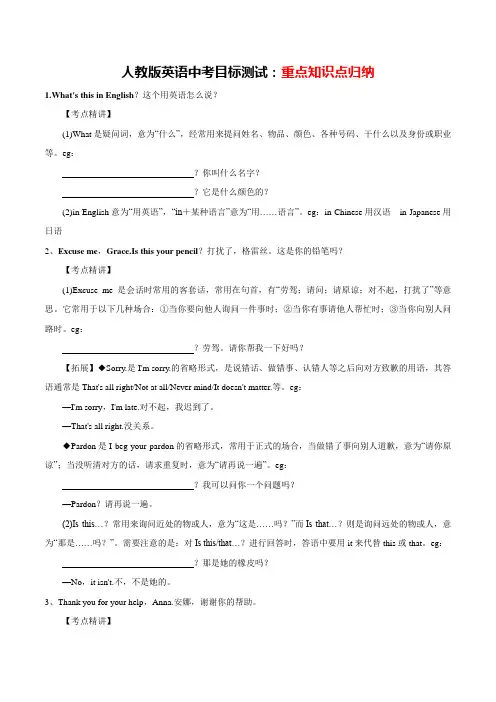
人教版英语中考目标测试:重点知识点归纳1.What's this in English?这个用英语怎么说?【考点精讲】(1)What是疑问词,意为“什么”,经常用来提问姓名、物品、颜色、各种号码、干什么以及身份或职业等。
eg:?你叫什么名字??它是什么颜色的?(2)in English意为“用英语”,“in+某种语言”意为“用……语言”。
eg:in Chinese用汉语in Japanese用日语2、Excuse me,Grace.Is this your pencil?打扰了,格雷丝。
这是你的铅笔吗?【考点精讲】(1)Excuse me是会话时常用的客套话,常用在句首,有“劳驾;请问;请原谅;对不起,打扰了”等意思。
它常用于以下几种场合:①当你要向他人询问一件事时;②当你有事请他人帮忙时;③当你向别人问路时。
eg:?劳驾。
请你帮我一下好吗?【拓展】◆Sorry.是I'm sorry.的省略形式,是说错话、做错事、认错人等之后向对方致歉的用语,其答语通常是That's all right/Not at all/Never mind/It doesn't matter.等。
eg:—I'm sorry,I'm late.对不起,我迟到了。
—That's all right.没关系。
◆Pardon是I beg your pardon的省略形式,常用于正式的场合,当做错了事向别人道歉,意为“请你原谅”;当没听清对方的话,请求重复时,意为“请再说一遍”。
eg:?我可以问你一个问题吗?—Pardon?请再说一遍。
(2)Is this…?常用来询问近处的物或人,意为“这是……吗?”而Is that…?则是询问远处的物或人,意为“那是……吗?”。
需要注意的是:对Is this/that…?进行回答时,答语中要用it来代替this或that。
eg:?那是她的橡皮吗?—No,it isn't.不,不是她的。
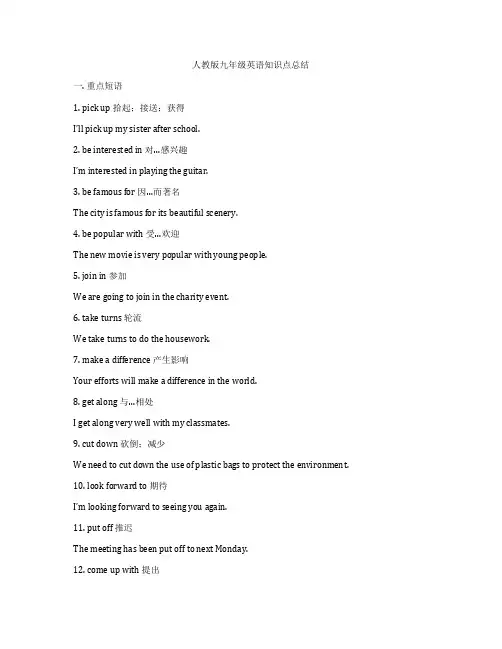
人教版九年级英语知识点总结一. 重点短语1. pick up 拾起;接送;获得I’ll pick up my sister after school.2. be interested in 对…感兴趣I’m interested in playing the guitar.3. be famous for 因…而著名The city is famous for its beautiful scenery.4. be popular with 受…欢迎The new movie is very popular with young people.5. join in 参加We are going to join in the charity event.6. take turns 轮流We take turns to do the housework.7. make a difference 产生影响Your efforts will make a difference in the world.8. get along 与…相处I get along very well with my classmates.9. cut down 砍倒;减少We need to cut down the use of plastic bags to protect the environment.10. look forward to 期待I’m looking forward to seeing you again.11. put off 推迟The meeting has been put off to next Monday.12. come up with 提出We need to come up with a plan for the project. 13. keep in touch 保持联系We keep in touch by sending emails.14. make up 编造;弥补She made up a story about why she was late.15. run out of 用完We have run out of milk and need to buy some more.二. 重点语法1. 一般现在时肯定句:主语 + V原 + 其他He plays football every weekend.否定句:主语 + do not/does not + V原 + 其他I do not like watching horror movies.疑问句:Do/Does + 主语 + V原 + 其他Do they enjoy playing basketball?2. 一般过去时肯定句:主语 + V-ed/Vt + 其他She visited Beijing last year.否定句:主语 + did not + V原 + 其他We did not go to the concert last night.疑问句:Did + 主语 + V原 + 其他Did you finish your homework yesterday?3. 现在进行时肯定句:主语 + am/is/are + V-ing + 其他She is watching TV now.否定句:主语 + am/is/are + not + V-ing + 其他He is not playing football at the moment.疑问句:Am/Is/Are + 主语 + V-ing + 其他Are you studying for the exam?4. 一般将来时肯定句:主语 + will + V原 + 其他She will travel to Japan next month.否定句:主语 + will not + V原 + 其他I will not forget to call you.疑问句:Will + 主语 + V原 + 其他Will he come to the party?5. 现在完成时肯定句:主语 + have/has + V过去分词 + 其他They have finished their homework.否定句:主语 + have/has + not + V过去分词 + 其他We have not seen this movie yet.疑问句:Have/Has + 主语 + V过去分词 + 其他Have you ever been to Paris?6. 被动语态肯定句:主语 + am/is/are + V过去分词 + 其他The book is written by my favorite author.否定句:主语 + am/is/are + not + V过去分词 + 其他The dishes are not washed by my brother.疑问句:Am/Is/Are + 主语 + V过去分词 + 其他Is the car fixed by the mechanic?三. 重点词汇1. 人物teacher 老师student 学生doctor 医生nurse 护士engineer 工程师pilot 飞行员musician 音乐家actor 演员writer 作家scientist 科学家athlete 运动员2. 动作run 跑步jump 跳跃swim 游泳dance 跳舞sing 唱歌play 演奏climb 爬山cook 烹饪paint 绘画ride 骑行3. 环境house 房子school 学校hospital 医院office 办公室library 图书馆park 公园beach 海滩mountain 山river 河lake 湖四. 重点句型1. 八大情态动词can 能够I can speak English fluently.could 过去能够She could play the piano when she was five. may 可能May I go to the restroom, please?might 可能It might rain this afternoon.must 必须You must finish your homework before 8pm. shall 将要Shall we go to the movies tonight?should 应该You should study for the exam tomorrow.will 将要We will visit the Great Wall next week.2. 祈使句Be quiet! 安静!Don’t be late! 别迟到!Sit down, please. 请坐下。
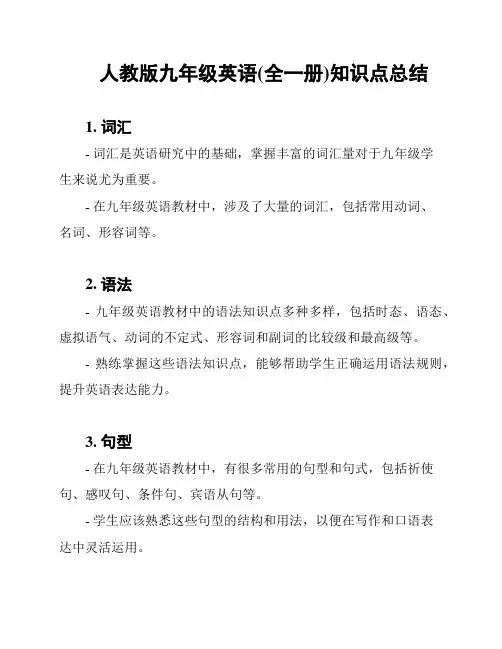
人教版九年级英语(全一册)知识点总结
1. 词汇
- 词汇是英语研究中的基础,掌握丰富的词汇量对于九年级学
生来说尤为重要。
- 在九年级英语教材中,涉及了大量的词汇,包括常用动词、
名词、形容词等。
2. 语法
- 九年级英语教材中的语法知识点多种多样,包括时态、语态、虚拟语气、动词的不定式、形容词和副词的比较级和最高级等。
- 熟练掌握这些语法知识点,能够帮助学生正确运用语法规则,提升英语表达能力。
3. 句型
- 在九年级英语教材中,有很多常用的句型和句式,包括祈使句、感叹句、条件句、宾语从句等。
- 学生应该熟悉这些句型的结构和用法,以便在写作和口语表
达中灵活运用。
4. 阅读理解
- 九年级英语教材中包含了大量的阅读理解题目,旨在培养学
生的阅读理解能力和阅读速度。
- 学生们应注重练阅读理解技巧,包括寻找关键词、理解上下
文等,从而更好地理解和回答问题。
5. 写作
- 九年级英语教材中也包含了一些写作练,如写作短文、信件、日记等。
- 学生们应该积极参与写作练,通过实践来提升写作能力,包
括语言表达、句子结构、逻辑思维等方面。
6. 听力
- 九年级英语教材中的听力部分涵盖了各种场景和对话,学生
们应该通过听力练来提升听力理解能力。
- 学生们可以通过多听、多练来加强对不同语速和口音的理解
能力。
这份文档总结了人教版九年级英语教材的主要知识点,包括词汇、语法、句型、阅读理解、写作和听力。
希望能够帮助学生们有效地学习和掌握这些知识点,提升英语能力。
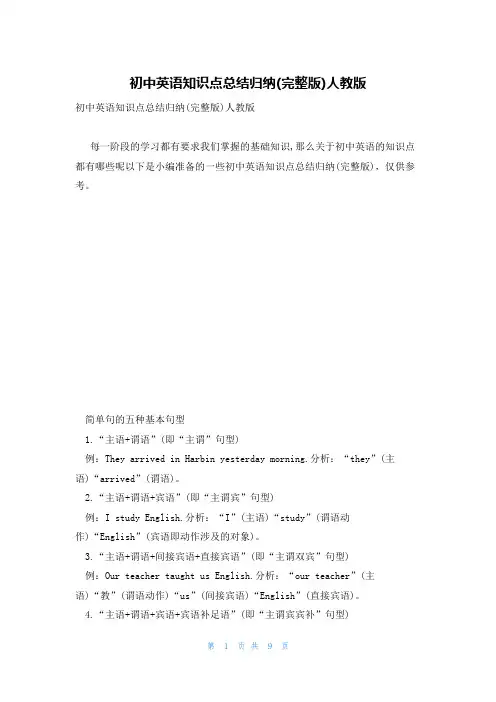
初中英语知识点总结归纳(完整版)人教版初中英语知识点总结归纳(完整版)人教版每一阶段的学习都有要求我们掌握的基础知识,那么关于初中英语的知识点都有哪些呢以下是小编准备的一些初中英语知识点总结归纳(完整版),仅供参考。
简单句的五种基本句型1.“主语+谓语”(即“主谓”句型)例:They arrived in Harbin yesterday morning.分析:“they”(主语)“arrived”(谓语)。
2.“主语+谓语+宾语”(即“主谓宾”句型)例:I study English.分析:“I”(主语)“study”(谓语动作)“English”(宾语即动作涉及的对象)。
3.“主语+谓语+间接宾语+直接宾语”(即“主谓双宾”句型)例:Our teacher taught us English.分析:“our teacher”(主语)“教”(谓语动作)“us”(间接宾语)“English”(直接宾语)。
4.“主语+谓语+宾语+宾语补足语”(即“主谓宾宾补”句型)例:He asked her to go there.分析:“he”(主语)“asked”(谓语动作)“her”(宾语即动作涉及的对象)“to go there”(补语—补充说明宾语做什么)。
5.“主语+系动词+表语”(即“主系表”句型)常用的系动词有be, keep,lie, remain, stand, become, fall, get, go, grow, turn, look, feel, seem, smell, sound, taste,等。
例:I am a teacher.分析:“I”(主语)“am”(系动词)“a teacher”(表语—即表明主语的身份)。
初中英语八种基本时态1. 一般现在时概念: 表示经常发生的动作或经常存在的状态。
常和 always , often , usually , sometimes , every day 等表时间的状语连用。

中考人教版英语知识点归纳总结中考英语是对学生英语综合运用能力的一次重要检验,人教版英语教材以其系统性和实用性在中考备考中占据重要地位。
以下是中考人教版英语知识点的归纳总结:词汇篇- 掌握中考大纲要求的词汇量,包括基础词汇和拓展词汇。
- 学习词汇的派生形式,如名词、动词、形容词、副词等。
- 了解词汇的词义辨析,尤其是同义词和近义词的用法。
语法篇- 掌握基本的时态,如一般现在时、一般过去时、一般将来时、现在进行时等。
- 学习被动语态和主动语态的转换。
- 理解并运用各种从句,包括定语从句、状语从句、宾语从句等。
- 熟悉非谓语动词的用法,如动名词、不定式、分词。
句型篇- 掌握基本的五种基本句型:主语+谓语、主语+谓语+宾语、主语+系动词+表语、主语+谓语+间接宾语+直接宾语、主语+谓语+宾语+宾语补足语。
- 学习并列句和复合句的构成。
阅读理解篇- 提高快速阅读和寻找信息的能力。
- 学会根据上下文猜测生词的意思。
- 练习概括文章的主旨大意和细节理解。
完形填空篇- 理解上下文,把握文章大意。
- 注意词汇的固定搭配和语境中的用法。
- 练习逻辑推理和语篇理解。
写作篇- 掌握各种写作体裁,如记叙文、议论文、说明文等。
- 学习如何组织文章结构,包括引言、正文和结尾。
- 练习使用恰当的连接词和过渡句。
听力篇- 练习听力理解,包括对话、短文和长对话。
- 学会捕捉关键信息和细节。
- 提高对不同口音和语速的适应能力。
口语篇- 练习日常会话和情景对话。
- 学习正确的语音和语调。
- 增强语言的流利度和自然度。
复习策略篇- 制定合理的复习计划,均衡各个知识点的学习。
- 定期进行模拟测试,检验学习效果。
- 分析错误,查漏补缺,不断改进。
结束语:中考英语的备考是一个系统工程,需要学生在词汇、语法、句型、阅读、写作、听力和口语等多个方面进行综合训练。
希望以上的知识点归纳总结能够帮助学生更好地复习和准备中考,取得理想的成绩。
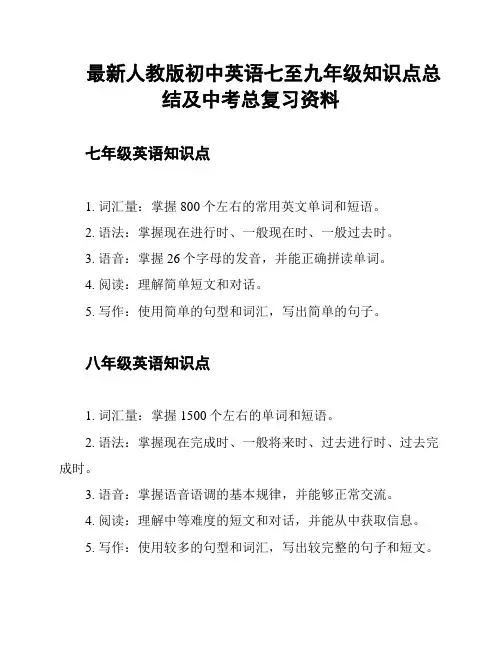
最新人教版初中英语七至九年级知识点总结及中考总复习资料七年级英语知识点1. 词汇量:掌握800个左右的常用英文单词和短语。
2. 语法:掌握现在进行时、一般现在时、一般过去时。
3. 语音:掌握26个字母的发音,并能正确拼读单词。
4. 阅读:理解简单短文和对话。
5. 写作:使用简单的句型和词汇,写出简单的句子。
八年级英语知识点1. 词汇量:掌握1500个左右的单词和短语。
2. 语法:掌握现在完成时、一般将来时、过去进行时、过去完成时。
3. 语音:掌握语音语调的基本规律,并能够正常交流。
4. 阅读:理解中等难度的短文和对话,并能从中获取信息。
5. 写作:使用较多的句型和词汇,写出较完整的句子和短文。
九年级英语知识点1. 词汇量:掌握2500个左右的单词和短语。
2. 语法:掌握虚拟语气、情态动词、时态的灵活运用。
3. 语音:较好地掌握语音语调的基本规律,并能够流利地交流。
4. 阅读:理解较难的短文和对话,并能从中获取具体信息和总体意思。
5. 写作:使用较复杂的句型和词汇,写出较长、较完整的文稿,如信件、报道等。
中考复资料1. 语音:掌握26个字母的发音及其规则,尤其注意常见辅音字母用法,如c、g、h、w、y等。
2. 词汇:重点掌握高中必修课程、T单词、高考词组和短语、高考作文词汇、扩展词汇等。
3. 语法:掌握常见语法规则、虚拟语气、形容词比较级和最高级、动词不定式、句型转换等。
4. 阅读:重点训练阅读技巧和阅读速度,掌握快速阅读和准确理解文章的方法。
5. 写作:重点训练写作技巧和写作思路,掌握高考作文的结构和技巧,同时注重写作论证、表达和逻辑。
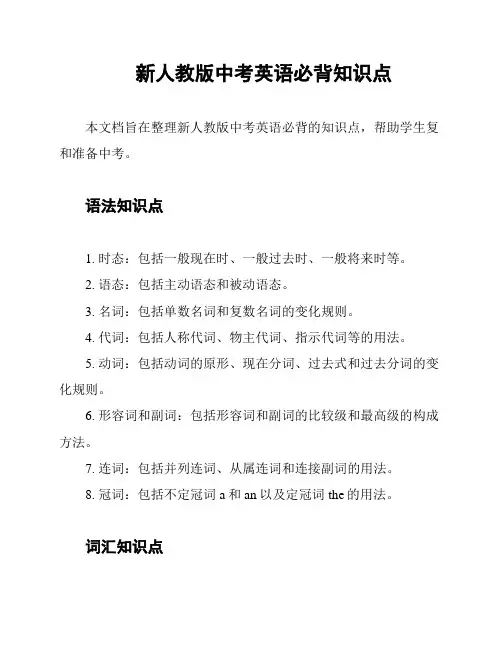
新人教版中考英语必背知识点
本文档旨在整理新人教版中考英语必背的知识点,帮助学生复和准备中考。
语法知识点
1. 时态:包括一般现在时、一般过去时、一般将来时等。
2. 语态:包括主动语态和被动语态。
3. 名词:包括单数名词和复数名词的变化规则。
4. 代词:包括人称代词、物主代词、指示代词等的用法。
5. 动词:包括动词的原形、现在分词、过去式和过去分词的变化规则。
6. 形容词和副词:包括形容词和副词的比较级和最高级的构成方法。
7. 连词:包括并列连词、从属连词和连接副词的用法。
8. 冠词:包括不定冠词a和an以及定冠词the的用法。
词汇知识点
1. 同义词和反义词:常见的同义词和反义词的词汇搭配。
2. 常用词组和短语:包括日常用语和常见表达方式。
3. 常用句型:包括肯定句、否定句、疑问句等常见句型的构成方法。
4. 高频词汇:根据新人教版中考英语词汇表列出的高频词汇。
阅读技巧
1. 扫读:快速浏览文章,获取整体意思和主要段落。
2. 略读:通过粗略阅读确定文章的主旨和重点信息。
3. 细读:仔细阅读文章,理解细节和推理出作者的观点。
4. 推理:根据文章的线索和上下文进行推理判断。
5. 标记关键词:根据题目要求,在文章中标记关键词以方便查找答案。
以上是新人教版中考英语必背的知识点和阅读技巧,希望能对同学们的复习和备考有所帮助。
祝大家取得好成绩!。
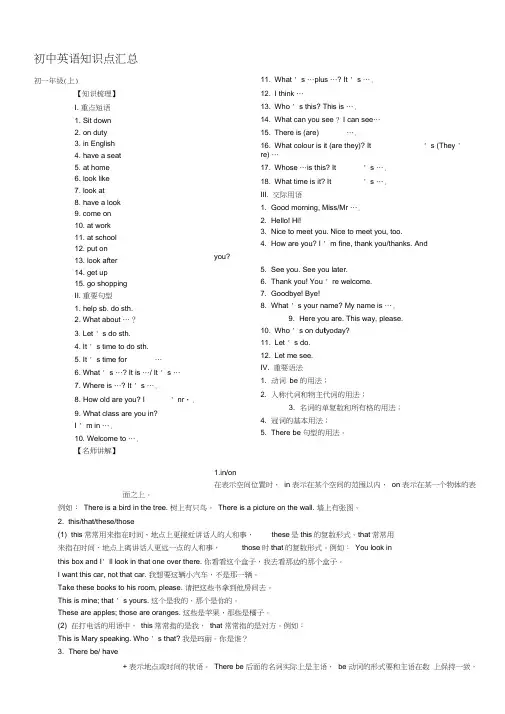
11. What ' s …plus …? It ' s …. 12. I think …13. Who ' s this? This is …. 14. What can you see ? I can see … 15. There is (are)….16. What colour is it (are they)? It ' s (They 're) …17. Whose …is this? It ' s …. 18. What time is it? It ' s ….III. 交际用语1. Good morning, Miss/Mr ….2. Hello! Hi!3. Nice to meet you. Nice to meet you, too.4. How are you? I ' m fine, thank you/thanks. And you?5. See you. See you later.6. Thank you! You ' re welcome.7. Goodbye! Bye!8. What ' s your name? My name is ….9. Here you are. This way, please.10. Who ' s on du t yoday? 11. Let ' s do. 12. Let me see. IV. 重要语法 1. 动词 be 的用法;2. 人称代词和物主代词的用法;3. 名词的单复数和所有格的用法;4. 冠词的基本用法;5. There be 句型的用法。
1.in/on在表示空间位置时, in 表示在某个空间的范围以内, on 表示在某一个物体的表面之上。
例如: There is a bird in the tree. 树上有只鸟。
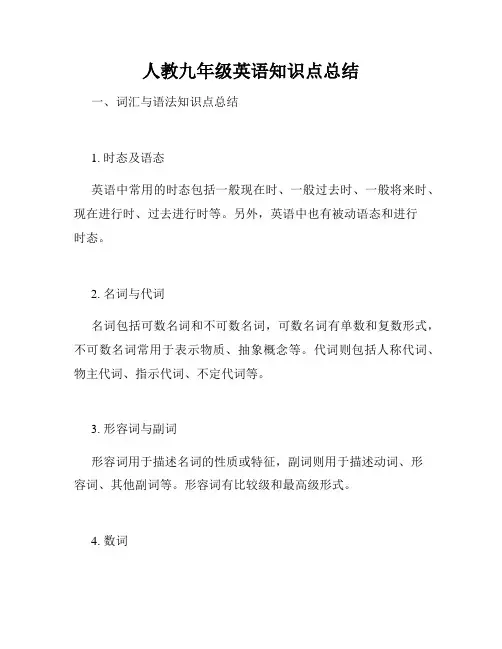
人教九年级英语知识点总结一、词汇与语法知识点总结1. 时态及语态英语中常用的时态包括一般现在时、一般过去时、一般将来时、现在进行时、过去进行时等。
另外,英语中也有被动语态和进行时态。
2. 名词与代词名词包括可数名词和不可数名词,可数名词有单数和复数形式,不可数名词常用于表示物质、抽象概念等。
代词则包括人称代词、物主代词、指示代词、不定代词等。
3. 形容词与副词形容词用于描述名词的性质或特征,副词则用于描述动词、形容词、其他副词等。
形容词有比较级和最高级形式。
4. 数词数词包括基数词和序数词,基数词用于表示数量,序数词用于表示顺序。
5. 介词与连词介词用于连接词语与句子的关系,连词用于连接短语、从句、句子等。
6. 句子结构英语中的句子结构包括主语、谓语、宾语、定语和状语等。
句子类型包括陈述句、疑问句、感叹句、祈使句等。
7. 从句从句是指在一个句子中充当某一成分的句子,包括名词性从句、定语从句和状语从句。
二、阅读与理解知识点总结1. 阅读策略阅读策略包括预测、扫描、略读、细读等,有助于提高阅读速度和理解能力。
2. 阅读技巧阅读技巧包括理解上下文、猜词义、判断文意、找主题句等,可以帮助读者更好地理解文章。
3. 阅读题型常见的阅读题型有选择题、判断题、填空题、匹配题等,需要根据文章内容进行准确的答题。
三、写作知识点总结1. 写作结构一篇英语作文通常包括引言、主体和结尾三部分,需要有清晰的结构和逻辑性。
2. 写作技巧写作技巧包括使用恰当的词汇和语法、合理运用连词和过渡词、掌握段落结构和句型变化等。
3. 写作主题写作主题可以包括个人经历、观点表达、问题分析等,需要有明确的中心思想和清晰的论述。
四、听力与口语知识点总结1. 听力技巧有效的听力技巧包括提前预测、注意关键词、理解上下文、抓住主旨等。
2. 口语表达口语表达需要注意语音、语调、语速和语法的准确使用,避免直译和中式英语的问题。
以上是人教九年级英语知识点的总结。
山西省人教新目标初中英语中考知识点1名词(名词的可数与不可数、名词的单复数、名词的所有格)2代词(人称代词、物主代词、反身代词、疑问代词、不定代词)3动词(动词的分类、用法;动词的时态及语态)4 形容词及副词(在句子中的成分)(原级、比较级、最高级)初二上册6、12单元5 介词及介词短语(基本词义及固定搭配)6 连词(并列连词和从属连词)7冠词(定冠词、不定冠词、零冠词)8 数词(基数词和序数词的基本用法)9 状语从句初二(下)5单元10宾语从句(连接词、时态的影响、语序)初三11单元11 定语从句(关系代词)初三6、7单元12 交际用语(单项选择、听力、补全对话题型出现)13 词语运用( 10分)(词类、句型理解、时态语态综合考查)14 完型填空和阅读理解(55分)占中考试卷的46%(词汇量、语法量、上下文联系、语言理解、逻辑推断能力)15 写作(15分)占中考试卷12.5%(英语语言思维及构建句子能力)初中英语时态及语态分布初一(上)一般现在时初一(下)一般过去时{Unit 9、Unit 10}初一(下)现在进行时{Unit 5、Unit 6}初二(上)①现在进行时表将来{Unit 3}②一般将来时{Unit 10}初二(下)①一般将来时{Unit 1}②过去进行时{Unit 3}③现在完成时{Unit 9}④现在完成进行时{Unit 6}初三①过去将来时{ Unit 4}②过去完成时{Unit 10}-------两大语态①主动语态②被动语态一般现在时和一般过去时的被动语态、情态动词的被动语态初三{Unit 3、Unit 9}。
人教版英语中考分册复习知识点Unit 1-Unit 2重点句型1. —My name’s Jenny. —I’m Gina. Nice to meet you.2. —What’s your/his/her name? —My/His/Her name is … .3. What’s your/his/her family/first name?4. —What’s your telephone number? —It’s 218-9176.5. What’s his/ her telephone number?6. —What’s this/that in English? —It’s a ruler.7. —Is this/that your pencil? —Yes, it is./No, it isn’t.8. How do you spell pencil?/Spell pencil./Can you spell pencil?9. Is that your computer game in the lost and found case?10. Call Alan at 495-3539.重点语法be在一般现在时中的基本用法:I用am, you用are,is跟着他她它。
He ,she ,it用is,we, you they都用are。
单数名词用is,复数名词都用are。
be的几种形式:is, am, are —being —was, were —been主谓一致:主谓一致的15种常考情况:1.表示时间,重量,数目,价格,长度,数学运算等的词或短语作主语时,尽管他们是复数形式,但如果把这些复数形式的词或短语看作是一个整体,谓语动词用单数形式。
Two months is quite a long time. Twenty dollars is enough.2.动词不定式,动名词,从句或不可数名词作主语时,谓语动词用单数。
P E P 九年级英语全册知纳 Unit1Howcanwebecomegoodlearners? 重点:1.学习并掌握用how 来询问做某事的方式;2.学习并掌握by+ving 来表 达做某事的方法。
难点:动名词在句中充当的成分。
知识点: askforhelp 寻求帮助w orkwithsb.和⋯⋯一起工作 haveconversationwith 和⋯⋯一起对话mainidea 中心思想thesecretto ⋯⋯的秘诀w ordbyword 逐字 taketime 花时间w ordgroup 词组b odylanguage 肢体语言expressionsonfaces 脸上的表情k eywords 关键词aswell 也lookup 查看t akenotes 记笔记 practicedoingsth.练习做某事 penpal 笔友keepadiary 记日记makemistakes 犯错i ncrease 增加;提高decrease 减少;降低 practicewithsb.和⋯⋯一起练习dependon 依赖whetherornot 是否payattentiontosth./doingsth.注意某事/做某事foralongtime 很长一段时间c onnect ⋯with ⋯把⋯⋯和⋯⋯连接起来writedown 写下mindmap 思维导图lifelongjourney 终身的旅程o none ’sown 独自地 bitbybit 一点点atonce 马上,立刻It ’sapieceofcake 小.菜一碟。
Itservesyouright.你活该。
Useitorloseit.Practicemakesperfect.Unit2Ithinkthatmooncakesaredelicious!重点&难点:1.that,if知识点:DragonBoatFestival 端午节S pringFestival 春节 LanternFestival 元宵节e atout 吃光 puton 增肥endup 最终成为 washawaybadthings 洗去灾祸g oodluck 好运intheshapeof 以⋯⋯的形式traditionalfolkstories 传统民间故事 shotdown 击落,打垮f lyupto 飞向 calloutone ’snam 喊e 出某人的名字layout 展示,安排 share ⋯withsb.和某人分享⋯⋯Itisagoodideatodosth.做某事是个好主意 do ⋯instead 做某事来代替playatrickon 开⋯⋯的玩笑 dressup 打扮hauntedhouse 鬼屋 thinkof 思考,考虑w arnsb,todosth.警告某人做某事 remindsb.ofsth.使某人想起某事promisetodosth.承诺做某事1Unit3Couldyoupleasetellmewheretherestroomare?重点:学习并掌握wh-&how 所引导的宾语从句。
人教版英语九年级全册知识点总结Unit1 How can we become good learners?【重点短语】1.have conversation with sb. 同某人谈话2.too…to…太……而不能3.the secret to………的秘诀4.be afraid of doing sth./ be afraid to do sth. 害怕做某事5.look up 查阅6.repeat out loud 大声跟读7.make mistakes in 在……方面犯错误8.connect ……with…把……和……连接/联系起来9.get bored 感到厌烦10.be stressed out 焦虑不安的11.pay attention to 注意;关注12.depend on 取决于;依靠13.the ability to do sth.. 做某事的能力【考点详解】1.by + doing 通过……方式(by 是介词,后面要跟动名词,也就是动词的 ing 形式)2.talk about 谈论,议论,讨论The students often talk about movie after class. 学生们常常在课后讨论电影。
talk to sb= talk with sb 与某人说话3.提建议的句子:①What/ how about +doing sth.? 做…怎么样?(about 后面要用动词的 ing 形式,这一点考试考的比较多)如:What/ How about going shopping?②Why don't you + do sth.? 你为什么不做…?如:Why don't you go shopping?③Why not + do sth. ? 为什么不做…?如:Why not go shopping?④Let's + do sth. 让我们做....... 吧。
Unit 1 How can we become good learners?学习目标认知目标:1. Talk about how to study. 学会讨论各种学习方法和策略。
2. Find out your suitable learning methods. 找出适合自己的学习方法。
情感目标:通过对学习方法的学习,培养学生用正确而科学的方法做事的能力,明白“一份耕耘,一份收获”。
技能目标:(1)熟练掌握下列词汇:aloud pronunciation discover repeat notepronounce increase speed partner createactive connect review knowledge wiselyborn attention(2)熟练掌握下列短语:work with friends ask the teacher for helpread aloud look up practice pronunciationconnect…with… pay attention to (3)掌握下列句型:How do you study English?I learn by working with a group.Do you learn English by reading aloud?Yes, I do. It helps my pronunciation.How can I read faster?You can read faster by reading word groups.How can I improve my pronunciation?One way is by listening to tapes.But whether or not you can do this well depends on your learning habits.重点、难点(Key points and difficulties)1. 学会运用how来询问做事方式2. 学会运用by + doing的结构表达做事方式。
人教版英语中考分册复习知识点Unit 1-Unit 2重点句型1. —My name’s Jenny. —I’m Gina. Nice to meet you.2. —What’s your/his/her name? —My/His/Her name is … .3. What’s your/his/her family/first name?4. —What’s your telephone number? —It’s 218-9176.5. What’s his/ her telephone number?6. —What’s this/that in English? —It’s a ruler.7. —Is this/that your pencil? —Yes, it is./No, it isn’t.8. How do you spell pencil?/Spell pencil./Can you spell pencil?9. Is that your computer game in the lost and found case?10. Call Alan at 495-3539.重点语法be在一般现在时中的基本用法:I用am, you 用are,is跟着他她它。
He ,she ,it用is,we, you they都用are。
单数名词用is,复数名词都用are。
be的几种形式:is, am, are —being —was, were —been主谓一致:主谓一致的15种常考情况:1.表示时间,重量,数目,价格,长度,数学运算等的词或短语作主语时,尽管他们是复数形式,但如果把这些复数形式的词或短语看作是一个整体,谓语动词用单数形式。
Two months is quite a long time.Twenty dollars is enough.2.动词不定式,动名词,从句或不可数名词作主语时,谓语动词用单数。
To see is to believe. It is not easy tomaster a foreign language.3.由and连接两个成分作主语时,要根据其表示的意义来决定谓语动词的形式。
如果其表示的是一个整体的概念或指的是同一事物,谓语动词用单数,如果其表示的是两个不同的对象时,谓语动词用复数。
The writer and the teacher are coming.The poet and teacher is one of my friends.4.集合名词people,police一般看作复数意义,其谓语动词用复数。
另外一些集合名词family,enemy,class,army等作主语时,谓语动词是用单数还是复数,要根据这些词在句中的实际含义而定。
当他们表示的是整体意义时,谓语用单数;当他们强调个体成员时,谓语动词用复数形式。
In England, people eat fish and chips.The Chinese people(民族)is a greatpeople.5.名词性物主代词mine,yours,his,hers,its,ours,theirs等作主语时,谓语动词的数取决于该代词所表示的意义是单数还是复数。
His parents are young, but mine are old.6.以s结尾的名词本身不表示复数意义时,谓语动词通常用单数形式,如news,physics,politics,maths等。
No news is good news. Physics is themost difficult subject for him.7.由or,either…or…,neither…nor…,not only…but also…等词连接名词或代词作主语时,谓语动词的数和最接近的主语一致。
Neither you nor Li Hua has been toShanghai before.8.以there,here开头的句子,若主语不止一个,其谓语动词的形式和邻近的那个主语一致。
There is a table and four chairs in theroom.Here are some books and paper for you.9.trousers,clothes,glasses,compasses,chopsticks等作主语时,谓语动词用复数。
但如果前面有a pair of短语时,谓语动词用单数。
Jim’s trousers are brown. The pair ofglasses is Mr. Green’s.10.由“a lot of/lots of/plenty of+名词”或“分数+名词”作主语时,谓语动词的单复数根据名词的单复数而定。
A lot of people have been to London.Three-fifths of the water is dirty.11.“a number of +复数名词”作主语时,谓语动词用复数;“the number of+复数名词”作主语时,谓语动词用单数。
A great number of birds fly to the south inwinter.The number of lions does not changemuch if people leave things as they are.12.代词something,anything,nothing,everyone,anybody,nobody,each,neither,either,little,much,one等作主语时,谓语动词用单数形式。
Neither of us is a boy。
Each of them has an English dictionary。
One of the students was late for school。
13.All,some none,most,any等代词作主语时,若其指复数概念,谓语动词用复数形式;若其指单数形式,则谓语动词用单数形式。
Not all work is difficult。
Not all the students are here。
14.有些形容词前面加上定冠词the,如the poor,the old,the yong,the rich,the dying等用来表示一类人时,主语为复数意义,谓语动词用复数。
The old are good taken care of。
15.Many a意为“许多”,但因后面跟的是单数名词,谓语动词应用单数形式。
Many a student has passed the exam。
练习:1.The news for my brother。
A. areB. wereC. beD. is2.A boy with two dogs when the earthquake rocked the city。
A. were sleepingB. isasleepC. was sleepingD. areasleep3.Everyone except Tom and John there when the meeting began。
A. areB. isC. wasD. were 4.Neither he nor I from Canada。
We are from Australia 。
A. isB. areC. amD. be5.Jim works hard on his Chineseand 。
A. so Lucy doesB. sois LucyC. so does LucyD. soLucy is6.Jenny and her parents going tovisit the Palace Museum tomorrow。
.A. isB. amC. areD. be7.Henry,with his friends,volleyball every afternoon。
A. playB. playsC. hasplayed D. have played8.Fish and chips the mosttake—away food in England。
A. areB. isC. wereD. was9.My family early in the morning。
A. getB. getsC. hasgot D. have got10.Maths my favorite subject。
A. beB. isC. amD. are11. How time flies! Three yearsreally a short time.A. isB. areC. wasD.were12. liu Xiang and Yao Ming are world-famoussports stars. Of them are the prideof China.A. BothB. NeitherC. AllD. None13. –Are the twins on the football team?-No, neither of them on theteam.A. isB. areC. wereD.be14. Not only his parents but also hisgrandfather to a lot of places ofinterest in our country since hey camehere.A. has goneB. has beenC. havegone D. have been15.There are enough in the fridge. Wedon’t need to buy any.A. milkB. tomatoesC. tomatosD. apple16. A report says hundreds and thousands oftrees in the Amazonrainforest last year.A. was cut downB. have been cutdownC. were cut downD. had been cutdownUnits3-4 复习要点1、介绍家庭成员This/That is my sister/brother/mother…These/Those are myparents/grandparents…Is this/that your sister/brother…? Yes, itis./No, it isn’t.Are these/those yourparents/grandparents…?Yes, they are. /No, they aren’t.There are 3/4/5 …people in my family.They are my father, my mother,…and I.2、关于方位介词或短语表方位的介词或短语有:in,on ,under,behind,near,next to,in front of,across from,…My book is on my desk, my pen is in my book…Where is the backpack/pencil…? It’sin/on/under….Where are the books/pens/balls…?They are in/on/under….3、把…带去给某人take …to e.g:Pleasetake these things to your sister.把…带来给某人bring…to e.g:C anyou bring my homework to school?二、代词( 有两种:人称代词和物主代词。